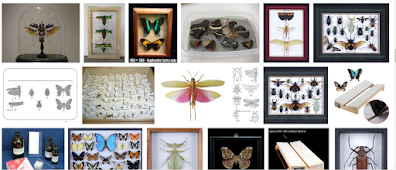Handling of collected insects depends on several factors, including the type of insect, the purpose of collection, and the intended use of the specimens. Here are some general guidelines:
The method of handling varies from group to group
1. Killing the insects:
Insects should be killed humanely and quickly. The most common
methods are freezing, using an insect-killing jar, or using ethyl acetate. Some
insects, such as those with hard exoskeletons, may require boiling or soaking
in hot water before preservation.
2. Relaxing Insect
Relaxing
insects is the process of making them pliable and easier to work with before
pinning and preservation. This is typically done after the insects have been
collected and killed in a killing jar. Here are the steps to relax insects:
- Remove the insects from the killing jar and place them in a sealed container with a piece of damp paper towel or cotton ball. The container should be large enough to accommodate the insects without crowding.
- Allow the insects to sit in the container for several hours to overnight. The length of time needed for relaxing the insects varies depending on the species, size, and the extent of the insect's stiffness.
- Check the insects periodically, and when they are pliable enough, gently manipulate their limbs and antennae to get them into the desired position.
- Once the insects are pliable, they can be pinned and dried using an insect pinning block, a foam-lined entomological box, or another suitable drying method.
3. Labeling:
Labeling the collected insects with information such as the
location, date, and collector's name is crucial for future reference and
research.
4. Preservation:
The preservation method depends on the intended use of the specimens.
Insects can be preserved dry, in alcohol, or in a pinned state. Pinned insects
should be placed in a labeled pinning box to prevent damage.
5. Storage:
Insects should be stored in a cool, dry, and dark place to prevent deterioration. If using alcohol as a preservation method, the specimens should be checked regularly for any discoloration or fungal growth.
6. Safety:
It is important
to follow the best practices and ethical guidelines for collecting and handling
insects to ensure that the specimens are preserved and used appropriately.
Methods of Insect Preservations
Insect preservation refers to the
methods used to protect, store and display insects for scientific research,
education, or personal collection. Here are some of the most common methods of
insect preservation:
1. Dry preservation:
This method involves drying insects
and preserving them in a dry environment. It is the most common and affordable
method of insect preservation. Insects can be air-dried, placed in silica gel,
or frozen before being placed in storage boxes.
2. Wet preservation:
This method involves preserving
insects in a liquid solution. The most common wet preservation method is called
"formalin-ethanol" and involves immersing the insects in a mixture of
formaldehyde and ethanol. This method is best for preserving delicate insects
or those with soft bodies.
3. Pinned preservation:
This method involves mounting
insects on insect pins and preserving them in a dry environment. This method is
best for displaying insects and preserving their physical features.
4. Slide mounting:
This method involves mounting very
small insects on glass slides using a special adhesive, which is then covered
with a cover slip. This method is best for observing and identifying
microscopic details.
5. Freeze-drying:
This method involves rapidly
freezing the insect, followed by drying it in a vacuum. This method is best for
preserving insects with soft bodies, such as butterflies and moths.









No comments:
Post a Comment